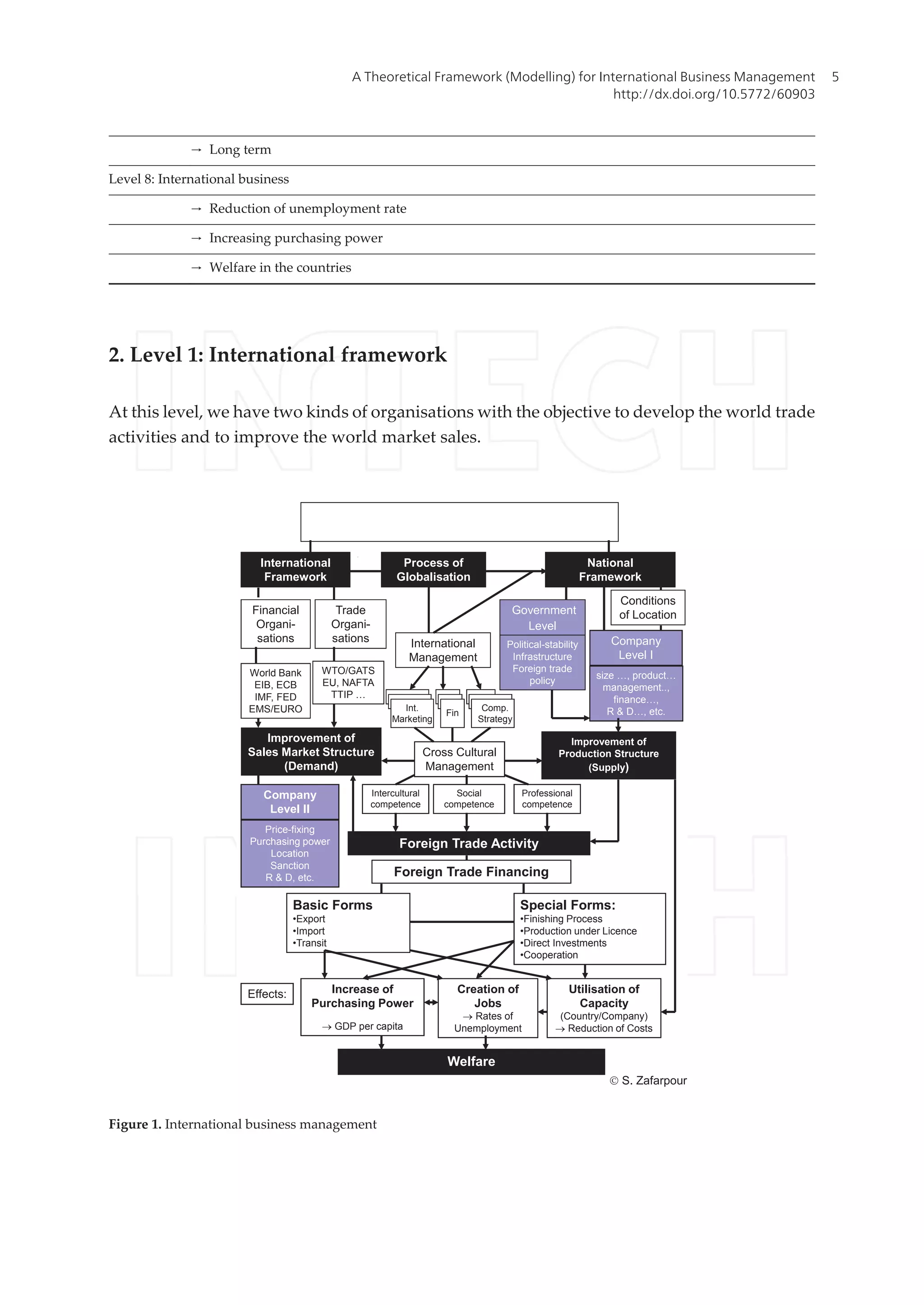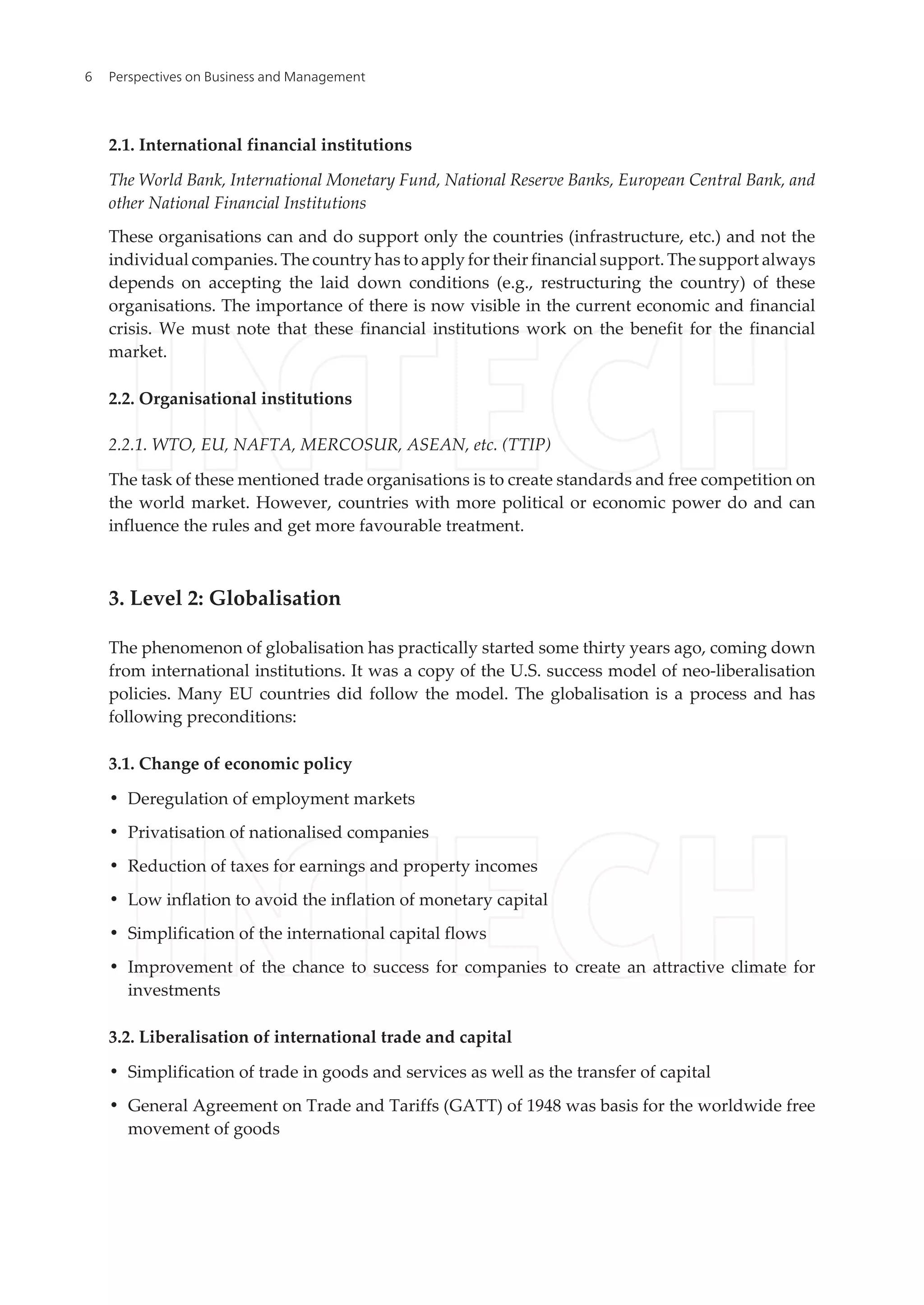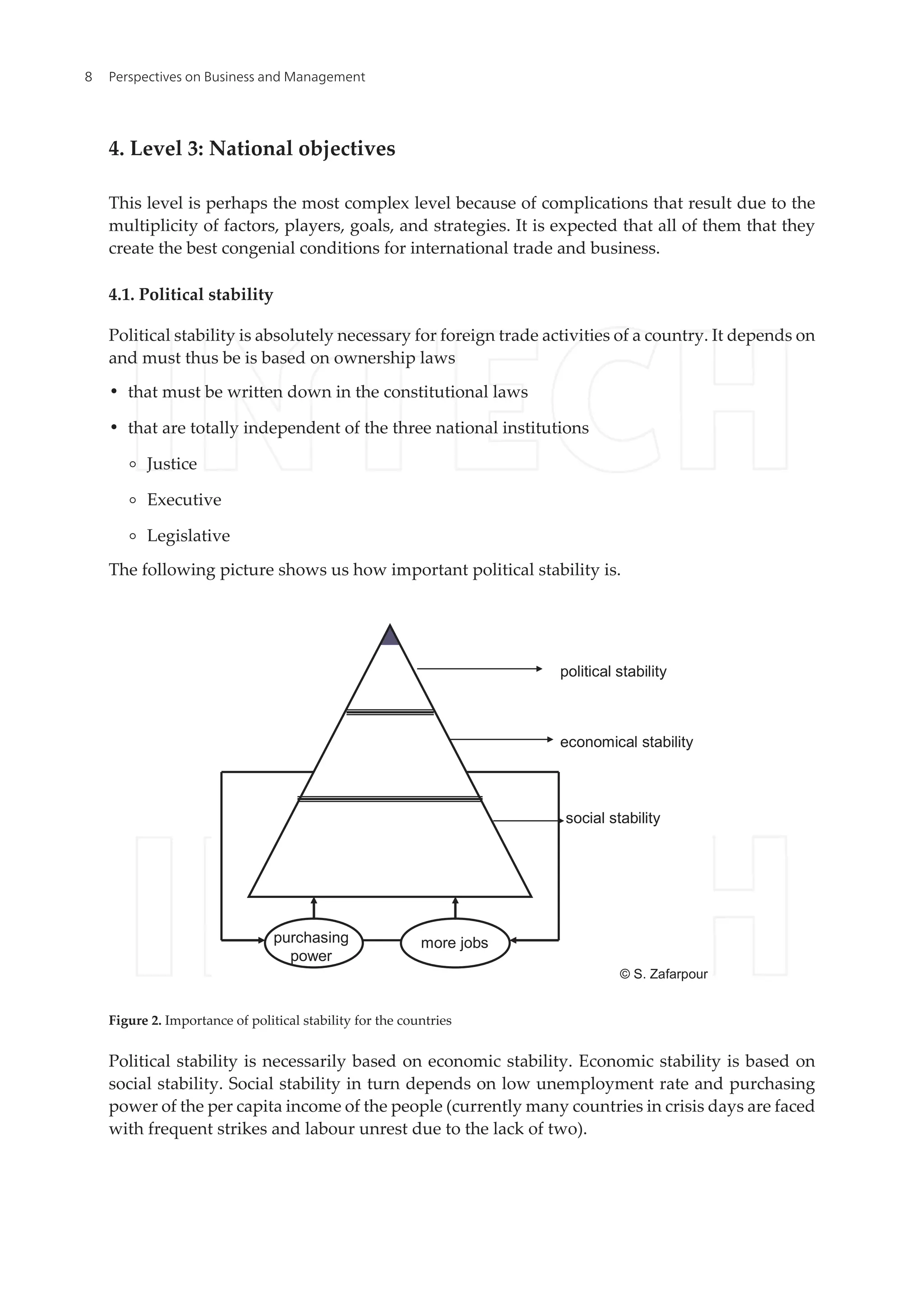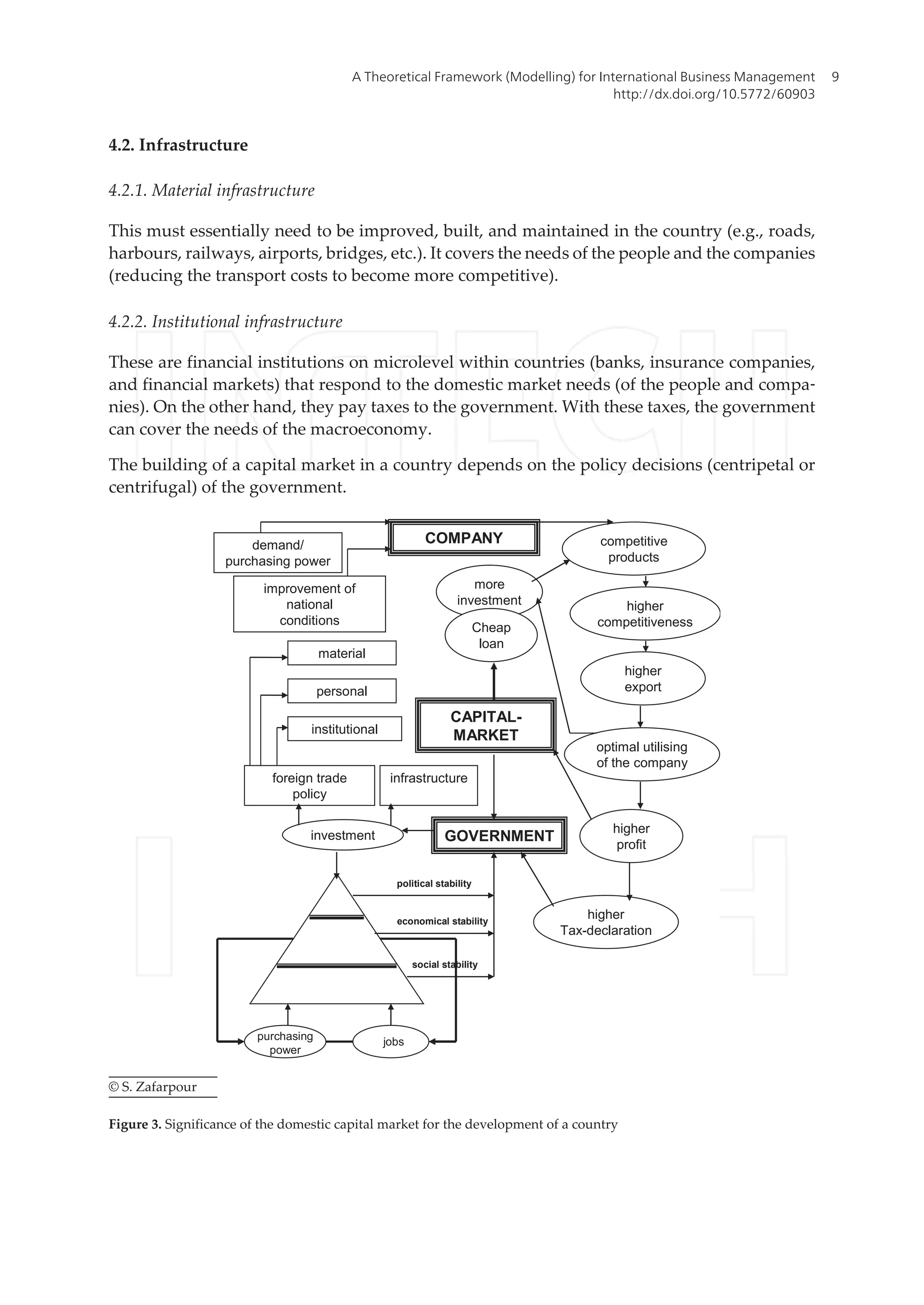The document presents a theoretical framework for international business management that addresses the complexities and dynamics of managing international trade. It highlights the importance of various levels, including international, national, and organizational structures, in influencing economic development and trade activities. The model proposed aims to illustrate how different factors interact and affect trade management, ultimately impacting national welfare and economic stability.
![Chapter 1
A Theoretical Framework (Modelling) for International
Business Management
Schapour Zafarpour
Additional information is available at the end of the chapter
http://dx.doi.org/10.5772/60903
Abstract
The international business management is one of the most relevant parts for the
development of the countries and at the same time the most complicated matter in
this complex. There are many economic players on different levels with different tasks
to achieve the final goal of the economy in a country, depending on the level of
development [1]. The need for managing international business arises in the flowing
areas or levels: 1. The international framework with all the institutions and organisa‐
tions that determine country’s economic and support policy in emergent situations.
2. Impact of globalisation on international and national policy and activities. 3. The
national framework, which fairly complicated because there are many active players:
a) National economic policy: understanding it and the environment for trade
activities. b) National economic structure and competiveness of the domestic
companies. c) International management capacities. d) Local or regional environment
and conditions for the companies. e) Focus on the world market conditions and their
development
1. Real trade activities in general and special types of countries. 2. Financing possi‐
bilities of trade activities according to the financing infrastructure (financial market)
in countries. 3. Benefit of trade balance to national development and economic welfare
of the people in countries concerned particularly: a) Increasing of the purchasing
power of the people, i.e., per capita income, b) Creating more employment opportu‐
nities
Keywords: International institutions, international organisations, globalisation
process, national support for international trade, international management, trade
activities, benefit of international trade activities on national development
© 2015 The Author(s). Licensee InTech. This chapter is distributed under the terms of the Creative Commons
Attribution License (http://creativecommons.org/licenses/by/3.0), which permits unrestricted use, distribution,
and reproduction in any medium, provided the original work is properly cited.](https://image.slidesharecdn.com/internationalbusiness-160623155617/75/A-Theoretical-Framework-Modelling-for-International-Business-Management-1-2048.jpg)
![1. Introduction
The aim of this paper is to show and to interpret the real motivation of international trade
business with all the benefits, barriers, and problems. The model we propose illustrates our
approach to International Business Management. Our proposed theoretical framework could
be easily applied and would probably hold good in practically 80%–90% of countries.
The international trade management is the backbone of every economy. This implies that the
trade balance of a country heavily influences the economic development of the country.
The process of managing international business is not an easy one because there are many
problems and barriers that need to be overcome to reach the ultimate goals of national
economic policy, i.e., the economic welfare of the people, which implies a low unemployment
level and a higher purchasing power of the income earners to meet their basic needs (for greater
details, see discussion by [2, 3].
Our model demonstrates the complexity and independency of different levels in international
business management. Each level has different goals and directions.
Level 1: International framework
→ Financial institutions
→ Organisational institutions
Level 2: Globalisation
Level 3: National objectives
→ Political stability
→ Infrastructure
→ Trade policy
Level 4: Location
Level 5: Company
→ Company structure
→ Decision-making process (management)
→ World market conditions
Level 6: Foreign trade activities
→ Basic
→ Special
Level 7: Foreign trade financing
→ Short term
→ Medium term
Perspectives on Business and Management4](https://image.slidesharecdn.com/internationalbusiness-160623155617/75/A-Theoretical-Framework-Modelling-for-International-Business-Management-2-2048.jpg)












![8. Level 7: Foreign trade financing
The financing of trade and any other businesses are of the most challenging barriers.
• The multinational companies have no big problems with it because of their own reserve
capital from one hand, and they are successful enough to get money from the banks.
• The middle-sized companies do not have problems until the balance is positive over many
years.
• The small-sized companies have more problems in this field if the percentage of own capital
is less than 30% of the investment volume and if the company cannot offer any guarantees
or property.
short-term
foreign trade financing
middle- and long-term
foreign trade financing
draft-financing
bank-financing
document-financing
- collection of fin. documents
- letter of credit
export-factoring
Instruments of foreign trade financing
delivery-credit
maintained credit
forfeiting
export-leasing
project financing
countertrade
special instruments of
foreign trade financing
Graphic 9: Financing on different levels
Source: Reinhard Moser
Source: modified S. Zafarpour based on Das Exportgeschäft (Moser R., Topritzhofer E.)
Figure 9. Financing on different levels
9. Level 8: International business
Every society basically aspires to have low unemployment, to have high rates of increase in
per capita national income, and to maximise economic and social welfare. This fundamental
idea has been imbibed in conventional Keynesian economics [4] and well implemented in the
New Deal policies of the United States in the 1930s. Keynesian policies have been largely
responsible for achieving the said goals at national and international level during the 1950s
and 1960s. The spell was broken in 1973 with stagflation and recession in the United States
and Europe. However, with the process of globalisation that started in the 1990s, the liberali‐
A Theoretical Framework (Modelling) for International Business Management
http://dx.doi.org/10.5772/60903
17](https://image.slidesharecdn.com/internationalbusiness-160623155617/75/A-Theoretical-Framework-Modelling-for-International-Business-Management-15-2048.jpg)

![References
[1] Rostow, W. W. (1962). The stages of economic growth. London: Cambridge University
Press.
[2] Maslow, A. (1943). A theory of human motivation. Psychological Review, Vol. 50, No.
4, pp. 370–396.
[3] Maslow, A. (1954). Motivation and personality, 1st ed. New York: Harper.
[4] Keynes, J. M. (1936). A general theory of employment, interest and money. London: Mac‐
millan. Michael E. Porter: Wettbewerbsstrategie, Campus Verlag, Frankfurt, 5 Au‐
flage 1988
[5] Buns, P., and Dewhurst, S. (1991). Small business and entrepreneurship. Macmillan.
[6] Popa, I., and Filip, R. (1999). Management international. Editura Economica.
[7] Piper, J. (1999). The way to trade. Pitmanpublishing.
[8] Dülfer, E., and Jöstingmeier B. (2008). Internationales management. Oldenbourg.
[9] Daniels, Radebough, and Sullivan. (2009). International business environment and opera‐
tions. Pearson.
[10] Magla, S. (2005). Cross cultural competence. Routledge.
[11] Livermore, D. (2010). Leading with cultural intelligence. Amazon.
[12] Moser, R., and Toprizhofer, E. (1986). Das Exportgeschäft. Service Verlag.
[13] Export/import in der praxis by Austrian Chamber of Commerce. (1992). Wirtschaftsverlag.
[14] Zafarpour, S. (1988). Grundlagen des internationalen Handels, Unterrichtsbehelf für
den Außenhandelskurs, BFI Wien.
[15] Zafarpour, S. (1993). Let’s go international. Einleitung und Problemstellung, Schriften‐
reihe des Zentrums für Auslandsstudien.
[16] Zafarpour, S. Internationalisierung und die dreidimensionale Managerausbildung, in
“der markt,” Zeitschrift für Absatzwirtschaft und Marketing, 32. Jahrgang,
1993/1994, Nr. 127 Vienna
[17] Zafarpour, S., and Fink G. (1995). Kultur & management, in Arbeitspapier Nr. 1, Ge‐
sellschaft für Ostkooperation, pp. 1–16, Vienna.
[18] Zafarpour, S. Manager im 21. Jahrhundert, in Festschrift Heinrich Stremitzer, Versi‐
cherung, Risiko und Internationalisierung, Hrsg: Josef Mugler, Linde Verlag Vienna,
pp. 485–496.
[19] Zafarpour, S. (1997). Außenhandelsstruktur der Alpen-Adria-Länder, in Tourism
and Hospitality Management, Vol. 3, No. 1, Vienna-Opatija, pp. 101–157.
A Theoretical Framework (Modelling) for International Business Management
http://dx.doi.org/10.5772/60903
19](https://image.slidesharecdn.com/internationalbusiness-160623155617/75/A-Theoretical-Framework-Modelling-for-International-Business-Management-17-2048.jpg)
![[20] Zafarpour, S. Journal of the International Association of Cross Cultural Management and
Competence, IKO Verlag, Frankfurt, co-editor.
[21] Zafarpour, S., and Bobek, V. (2000). Vergleich der Förderungssyteme für internatio‐
nale Direktinvestitionen in Österreich, Italien, Slowenien und Kroatien, in Ekonom‐
ska Misao i Praska (Economic Thougt and Practise) X, Dubrovnik.
[22] Zafarpour, S. (2001). Interkulturelle Kompetenz und Management in der globalen
Wirtschat, in Interkulturelles Management, Österreichische Perspektiven (Hrsg. G.
Fink/S. Meierwert). Wien: Springer Verlag, pp. 315–337.
[23] Moser, R./ Topritzhofer (1986), Das Exportgeschäft, Fachverlag an der Wirtschaftsu‐
niversität Wien.
[24] Schätzl, L (1981), Wirtschaftsgeographie I, UTB Schöningh Verlag, Paderborn/
München/Wien.
[25] Wagner, H.G. (1981), Wirtschaftsgeographie, Westermann, Braunschweig.
Perspectives on Business and Management20](https://image.slidesharecdn.com/internationalbusiness-160623155617/75/A-Theoretical-Framework-Modelling-for-International-Business-Management-18-2048.jpg)